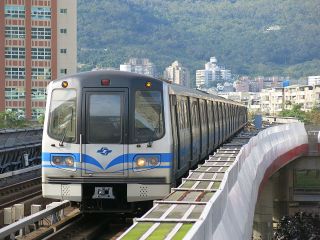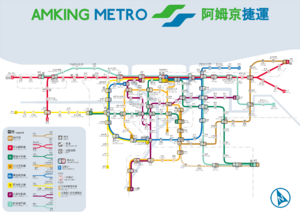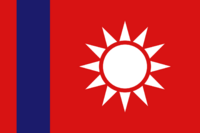Amking Metro
| Amking Metro | |||
|---|---|---|---|
 | |||
| Overview | |||
| Native name | 阿姆京捷運 | ||
| Locale | Amking, Baoan City | ||
| Transit type | Rapid transit | ||
| Number of lines | 8 | ||
| Number of stations | 141 served (123 owned) | ||
| Daily ridership | 3.3 million (March 2023) | ||
| Annual ridership | 1 billion (2022) | ||
| Website | www.amkingmetro.ms | ||
| Operation | |||
| Began operation | 10 January 1984 | ||
| Operator(s) | Amking Metro Company | ||
| |||
The Amking Metro, also known as the Amking MRT, is a rapid transit system serving Amking and Baoan City, Zaixian in Monsilva.
The metro originated as a group of private rail companies that were establishing networks throughout the capital as its population grew in the hope that passengers would bring the companies a large income. There were around 6 rail companies serving the Amking region by 1960, all of which were private and had little to no affiliation with the government. After the establishement of the Monsilvan Republic, the smaller companies began to be bought by the larger companies. In 1984, the last company that was left were aquired by the Amking State Government under the Amking Metro Company. This lead to the metro having much cheaper fares and therefore much high passenger numbers.
Most of the original network was overground, with tunnels occasionally under rivers and hills. However, in the 50s, tunnelling through the central urban region of Amking became popular amongst the rail companies. The majority of the current Amking metro network was built since 1984, most of which has been underground, however the metro consists of many above ground sections. The network consists of 141 stations, 18 of which are owned by the Monsilvan Railways Administration, whilst the rest are owned by the Amking Metro Company. The metro is made up of 8 different lines and is currently undergoing an expansion which will add 6 new stations to the network.
Contents
History
Proposal and construction
Rail transport was already a popular form of travel amongst citizens and tourists in Amking, when multiple independent rail companies managed systems throughout the region. However, prices offered by these companies were very high amd often complained about, however as they were private companies, nothing was done. In 1968, the mayor of Amking proposed a unified rail company to manage all networks in Amking which would be managed by the Monsilvan Railways Administration, which was owned by the government. This proposal was shelved due to fiscal concerns and the government decided to delay the proposal indefinitely due to more troubling issues the country was facing at the time.
In March 1979, not long after the establishment of the Monsilvan Republic, the proposal was introduced to the new provisional government. The proposal was accepted on the terms that the unified rail company is owned by the soon to be established Amking State Government. The provisional minister for transport provided a plan for the first section of the metro network and construction began in September 1979, with the last remaining rail company being aquired and dissolved by the provisional government. In 1983, construction of the first sections of the Red and Blue Lines had been completed and were opened by the Amking Metro Company in late 1984.
In 1989, the Department of Transport established the Department for City Transit Systems (DCTS) for the task of handling, planning, design, and construction of transit systems across the country. The Amking Metro Company becomes a part of the Amking division of DCTS and allows it to begin expanding the network with sufficient funding.
1992 expansion
In April 1990, an expansion to the metro network was proposed by the Amking Metro Company to the Amking State Government, which was accepted unanimously by the State Parliament. Funding was recieved by the DCTS and the State Government to add two new lines and several new stations. Construction began in August 1990 and finished in May 1992. The expansion opened the Orange and Green Lines, which were much smaller than they are today.
2001 expansion
In July 1997, another expansion to the metro network was proposed by the AMC. This proposal was barely passed by only 53% of the State Parliament. The expansion provided the addition of the Purple, Yellow and Brown lines as well as an expansion to the Red, Blue and Orange lines. Construction began in November 1997 and finished in August 2001. This was the largest expansion to the network in history and provided an additional 5 million people close access to the metro.
2009 expansion
In 2003, a third expansion was petitioned by people living in Amking. This expansion would include the addition of the Turquoise line as well as another extension to the Blue line and a new extension on the Green line. This petition was addressed by the Amking State Parliament the same year, but was rejected. Then, in December 2004, the petition was revived and was addressed by the Amking State Parliament again. This time, the expansion was accepted by the Parliament, and construction began in March 2005. When construction completed in January 2009, over 1 million people came to the new stations which caused much disruption to the network and lead to the new lines being shut for two weeks due to damage caused to infrastructure.
2015 expansion
In 2013, another expansion was proposed by the AMC. This was the metro's smallest expansion, with a suggestion of connecting the stations of West Gate and Nanguan with the Orange Line. The proposal was accepted by the Amking State Parliament later that year and construction began in January 2014 and finished in July 2015.
2024 expansion
In April 2021, a fifth expansion was proposed by the AMC to the State Parliament. This expansion will include a new branch on the Yellow Line, and a new branch on the Brown Line which will connect to Baoan station in Zaixian. The proposal was accepted by the Amking State Parliament in June 2021 and construction began in November. The construction is still ongoing and is expected to be finished by the end of March 2024.
Lines
| Icon | Full name | Services | Stations |
|---|---|---|---|

|
Caoju Line (Brown) | Caodi - Haoju | 19 |
| Caodi - Baoan (under construction) | 10 | ||

|
Tsaigong-Heju Line (Red) | Sigong Junction - Haoju | 22 |
| Sigong Junction - Heping | 22 | ||
| Tsaipei - Haoju | 22 | ||
| Tsaipei - Heping | 22 | ||

|
Yanghai-Maoan Line (Green) | Yanghai - Maodao | 10 |
| Yanghai - Baoan | 25 | ||

|
Amu-Puzhen Line (Orange) | Amking Central - Dazhen | 16 |
| Amking Central - Putou | 8 | ||
| Nanguan - Putou | 15 | ||

|
Chiangya-Tiejing Line (Blue) | Chiangya - Amking Central | 20 |
| Chiangya - Tieling | 22 | ||

|
Huantai-Xujing Line (Yellow) | Huantai - Amking Central | 15 |
| Huantai - Xu Zhou-da Airport | 13 | ||
| Huantai - Weihai (under construction) | 14 | ||

|
Dazhen-Zhongfei Line (Purple) | Dazhen - Hefei | 16 |
| Dazhen - Erqi | 18 | ||

|
Chenjia-Baomen Line (Turquoise) | Chenjia - Xiaonanmen | 17 |
| Chenjia - Baoan | 20 |
Fares and tickets
Fares range between M¥4 to M¥15 per trip as of 2019. Single journey tokens and rechargeable MetroPass cards are used to collect fares for day-to-day use. A 20% off discount was given to all IC card users. However, the discount for MetroPass card users was cancelled at the start of February 2018. The discount program was switched to an intensity-based scheme. The more times passengers take the metro, the higher the level of discount they could receive. For example, 10% discount is given for 11–20 rides; 20% discount is provided for 31–40 journeys; the highest discount is 30% off for more than 50 rides. The discount is considered a rebate, and is deposited to the user's card starting the first of each month from the previous month. Those with welfare cards issued by local governments could receive 60% off per ride. Anyone aged 18 or over pay adult fares. MRA tickets are valid only for journeys between MRA stations.
Safety and security
1998 typhoon flooding
On 7 July 1998, a 1998 Monsilvan typhoon flooded all underground tracks as well as 25 stations, the heavy-capacity system operation control center, the administration building, and two depots. Elevated sections of the metro were not affected and some services still ran during the repair period. However, MRA services didn't start running on the tracks again until 3 months later in October.
2009 Amking earthquake
On 14 April 2009, a magnitude 6.8 earthquake affected a large portion of southern Monsilva, including most of Amking. The earthquake was not expected to be as powerful as it was and unfortunately lead to the collapse of three stations as well as later flooding several stations including Amking Central. The collapsed stations lead to hundreds of people being trapped in the metro network, and some passengers head to be lead off trains and through the tunnels to get to the next open station as all trains had stopped.
2016 stabbing attack
On 14 December 2016, 12 people were stabbed in Hasi Station by a knife-wielding student who had overdosed on anabolic steroids . The attack resulted in the death of 3 people, whilst the other 9 victims were seriously injured. It was the first attack resulting in death that had occured on the network since it began operation in 1984. The suspect was a 20-year-old student at Amking Imperial College, who was arrested on the platforms at Hasi station immediately after stabbing his 12th victim. He was found guilty of mass homicide and intentional drug abuse and was sentenced to life in prison on 9 January 2017.



